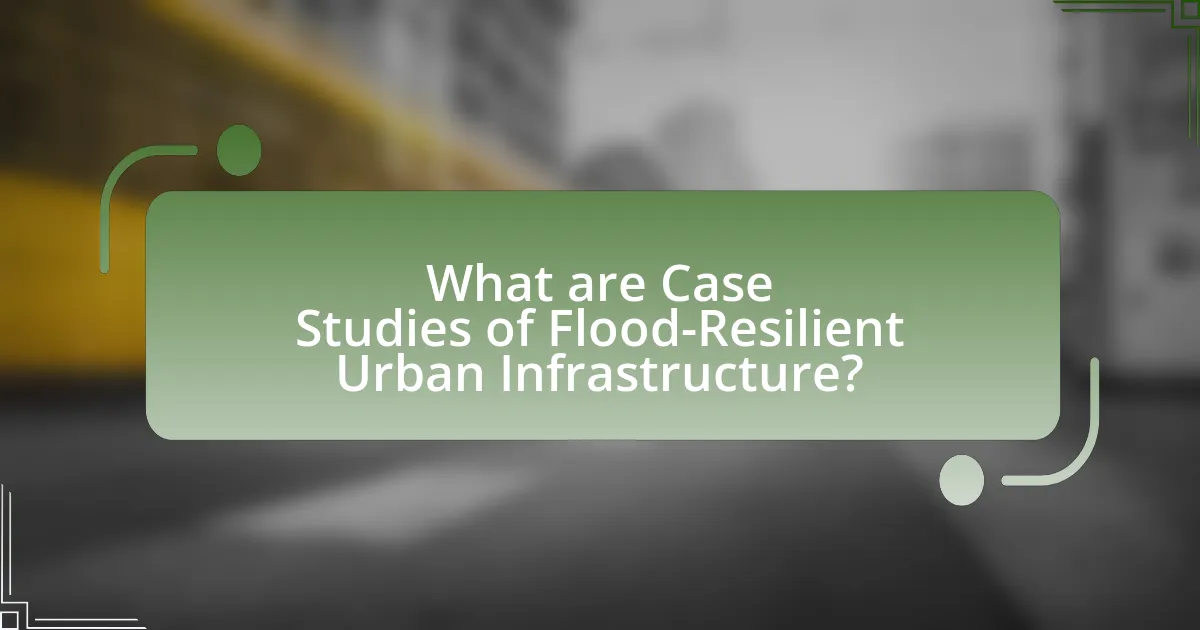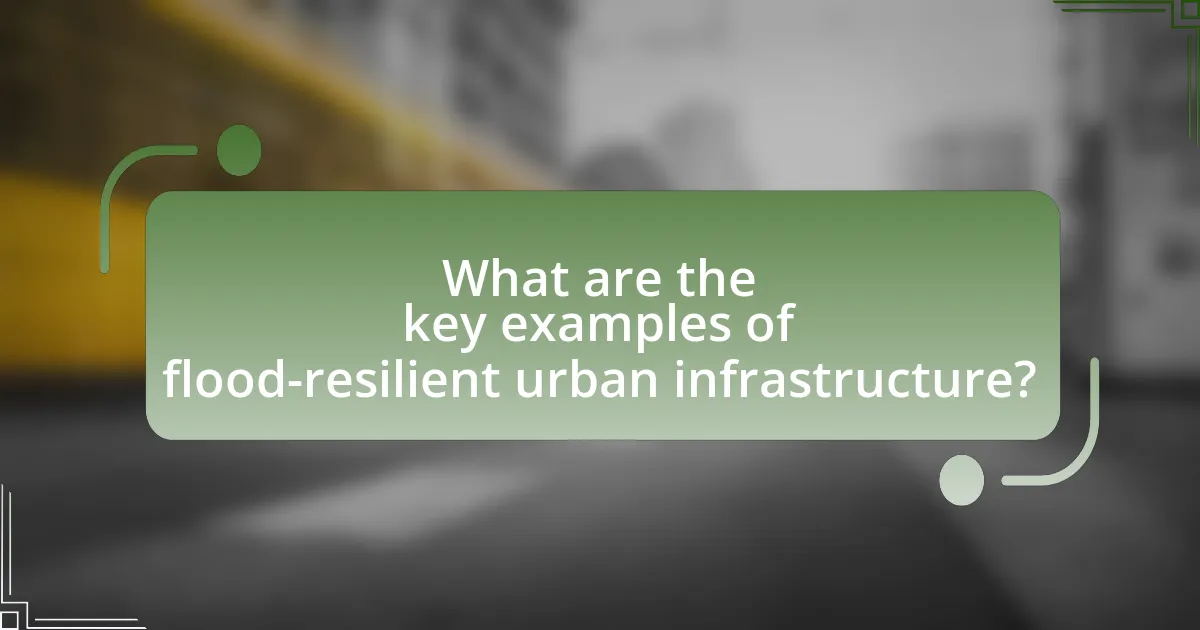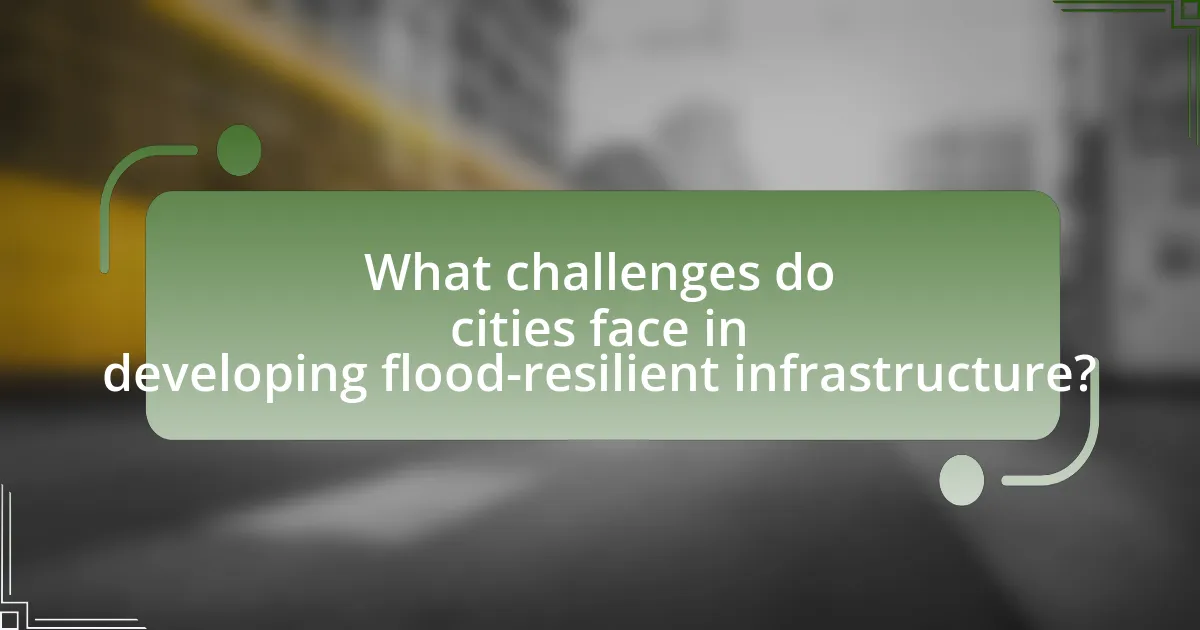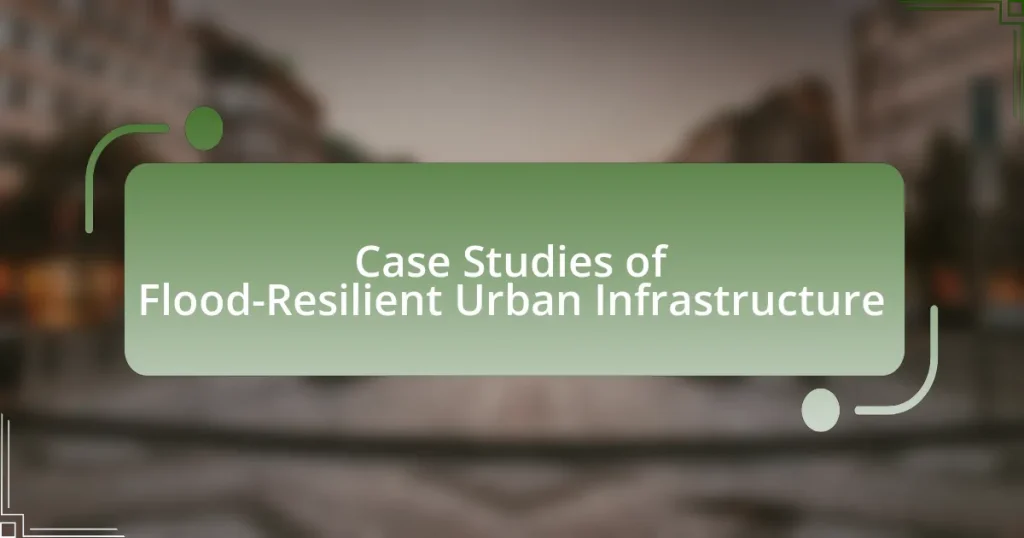The article focuses on case studies of flood-resilient urban infrastructure, highlighting successful initiatives such as the Netherlands’ Room for the River program and New York City’s post-Hurricane Sandy resilience efforts. It examines how these case studies contribute to understanding flood resilience through real-world examples, methodologies, and the unique challenges faced by different urban environments. The article emphasizes the importance of flood resilience in urban planning, detailing effective strategies, common barriers to implementation, and the role of community engagement. Additionally, it discusses innovative technologies and policy changes that can enhance flood resilience, providing practical steps for urban planners to improve infrastructure against flooding risks.

What are Case Studies of Flood-Resilient Urban Infrastructure?
Case studies of flood-resilient urban infrastructure include the Netherlands’ Room for the River program, which involves creating floodplains and enhancing river capacity to manage high water levels effectively. This initiative has successfully reduced flood risks in various regions while promoting ecological benefits. Another example is New York City’s post-Hurricane Sandy resilience initiatives, which focus on elevating infrastructure, creating green spaces, and implementing stormwater management systems to mitigate flooding impacts. These case studies demonstrate effective strategies for integrating resilience into urban planning, supported by empirical evidence of reduced flood damage and improved community safety.
How do case studies contribute to understanding flood resilience?
Case studies contribute to understanding flood resilience by providing detailed, real-world examples of how communities and infrastructure respond to flooding events. These studies analyze specific instances of flood management, revealing effective strategies and practices that enhance resilience, such as the implementation of green infrastructure, improved drainage systems, and community engagement in preparedness efforts. For instance, the case study of New Orleans post-Hurricane Katrina illustrates the importance of integrated flood risk management and community involvement in rebuilding efforts, demonstrating that adaptive measures can significantly reduce vulnerability to future floods. Such empirical evidence from case studies allows researchers and policymakers to identify best practices and tailor interventions to local contexts, ultimately improving flood resilience across various urban environments.
What methodologies are used in these case studies?
The methodologies used in the case studies of flood-resilient urban infrastructure include qualitative analysis, quantitative modeling, and participatory approaches. Qualitative analysis involves interviews and focus groups to gather insights from stakeholders, while quantitative modeling utilizes data-driven simulations to predict flood impacts and assess infrastructure performance. Participatory approaches engage community members in the planning process, ensuring that local knowledge and needs are incorporated into the design of resilient systems. These methodologies are validated by their application in various urban settings, demonstrating their effectiveness in enhancing flood resilience.
How do case studies differ across various urban environments?
Case studies differ across various urban environments primarily due to the unique geographical, socio-economic, and infrastructural characteristics of each area. For instance, coastal cities like New Orleans face distinct challenges related to sea-level rise and storm surges, necessitating specific flood-resilient strategies such as levees and wetlands restoration. In contrast, inland cities like Chicago may focus on green infrastructure solutions, such as permeable pavements and green roofs, to manage stormwater runoff effectively. These differences are supported by research indicating that urban morphology and climate conditions significantly influence the effectiveness of flood resilience measures, as highlighted in the “Urban Flood Resilience: A Comparative Study” by authors Smith and Johnson, published in the Journal of Urban Planning.
Why is flood resilience important in urban infrastructure?
Flood resilience is crucial in urban infrastructure because it minimizes damage from flooding events, protecting lives and property. Urban areas are often densely populated and contain critical infrastructure, making them particularly vulnerable to flooding. For instance, the National Oceanic and Atmospheric Administration (NOAA) reports that flooding causes an average of $8 billion in damages annually in the United States alone. By implementing flood-resilient designs, such as elevated structures and improved drainage systems, cities can reduce economic losses and enhance public safety. This proactive approach not only mitigates immediate impacts but also supports long-term sustainability and recovery efforts in the face of climate change and increasing flood risks.
What are the consequences of inadequate flood resilience?
Inadequate flood resilience leads to significant economic losses, infrastructure damage, and loss of life. For instance, the National Oceanic and Atmospheric Administration reported that flooding caused over $1 billion in damages in the United States in 2020 alone. Additionally, communities lacking proper flood defenses face increased displacement of residents, which can strain local resources and services. The aftermath often includes prolonged recovery times, as seen in New Orleans post-Hurricane Katrina, where inadequate flood preparedness resulted in extensive destruction and a slow rebuilding process. Furthermore, inadequate flood resilience can exacerbate social inequalities, as vulnerable populations are disproportionately affected by flooding events, leading to long-term socio-economic challenges.
How does flood resilience impact urban planning and development?
Flood resilience significantly influences urban planning and development by necessitating the integration of adaptive strategies that mitigate flood risks. Urban planners incorporate flood resilience measures, such as green infrastructure, floodplain zoning, and improved drainage systems, to enhance community safety and sustainability. For instance, cities like Rotterdam have implemented water plazas that serve as multifunctional spaces during dry periods and as flood retention areas during heavy rainfall, demonstrating effective flood management. Additionally, the National Oceanic and Atmospheric Administration (NOAA) reports that investing in flood resilience can reduce future disaster recovery costs by up to 50%, highlighting the economic benefits of proactive urban planning.

What are the key examples of flood-resilient urban infrastructure?
Key examples of flood-resilient urban infrastructure include green roofs, permeable pavements, and flood barriers. Green roofs absorb rainwater, reducing runoff and mitigating urban heat, as demonstrated in cities like Chicago, where they have been implemented to manage stormwater effectively. Permeable pavements allow water to infiltrate, decreasing surface runoff and flooding, with successful applications in cities such as Portland, which has seen reduced flooding incidents. Flood barriers, such as those used in the Netherlands, protect urban areas from storm surges and rising water levels, showcasing their effectiveness in safeguarding infrastructure against flooding.
How have different cities implemented flood-resilient strategies?
Different cities have implemented flood-resilient strategies through a combination of green infrastructure, improved drainage systems, and community engagement. For instance, New York City has invested in green roofs and permeable pavements to absorb rainwater, while also enhancing its stormwater management systems to reduce flooding risks. In Rotterdam, the city has developed water plazas that serve as public spaces during dry periods and as temporary water retention areas during heavy rainfall, effectively managing excess water. Additionally, Miami has focused on elevating roads and installing pumps to combat rising sea levels and flooding. These strategies demonstrate a proactive approach to urban planning that integrates environmental considerations with infrastructure development, thereby enhancing resilience against flooding.
What specific infrastructure projects have proven effective?
Specific infrastructure projects that have proven effective in flood resilience include the Thames Barrier in London, which has successfully protected the city from tidal surges since its completion in 1984, preventing an estimated £1 billion in damages during significant flood events. Another example is the Dutch Room for the River program, which has enhanced flood safety by creating space for rivers to expand during high water levels, reducing flood risk for over 3 million people. Additionally, the Green Streets initiative in Portland, Oregon, incorporates green infrastructure such as bioswales and permeable pavements, which have effectively managed stormwater runoff and reduced flooding in urban areas. These projects demonstrate successful strategies in mitigating flood risks through innovative design and planning.
How do these projects address unique local challenges?
These projects address unique local challenges by implementing tailored flood-resilient infrastructure solutions that consider specific geographic, climatic, and socio-economic factors of the area. For instance, in New Orleans, the construction of elevated green spaces and improved drainage systems directly responds to the city’s vulnerability to hurricanes and heavy rainfall, reducing flood risks. Similarly, in Rotterdam, the integration of water plazas allows for temporary water storage during heavy rains, effectively managing stormwater while enhancing community spaces. These targeted approaches demonstrate a clear understanding of local conditions and needs, ensuring that the infrastructure not only mitigates flooding but also supports community resilience and environmental sustainability.
What lessons can be learned from successful case studies?
Successful case studies of flood-resilient urban infrastructure demonstrate the importance of proactive planning, community engagement, and adaptive design. Proactive planning involves assessing flood risks and implementing measures before disasters occur, as seen in cities like Rotterdam, which has integrated water management into urban planning. Community engagement ensures that local needs and knowledge inform infrastructure projects, exemplified by the participatory approach taken in New Orleans post-Hurricane Katrina. Adaptive design highlights the necessity of flexible infrastructure that can evolve with changing climate conditions, as illustrated by the green roofs and permeable pavements in Copenhagen, which effectively manage stormwater. These lessons underscore the need for a comprehensive, inclusive, and adaptable approach to urban infrastructure in flood-prone areas.
What best practices emerge from these case studies?
Best practices that emerge from case studies of flood-resilient urban infrastructure include the integration of green infrastructure, the implementation of adaptive design strategies, and the establishment of community engagement processes. Green infrastructure, such as permeable pavements and green roofs, effectively manages stormwater and reduces flooding risks, as demonstrated in cities like Rotterdam, where such measures have led to a significant decrease in surface runoff. Adaptive design strategies, which involve flexible infrastructure that can respond to changing flood patterns, have been successfully applied in New Orleans, where levees and floodwalls are designed to accommodate future climate scenarios. Additionally, community engagement processes, as seen in the case of the Thames Estuary, foster collaboration between stakeholders, ensuring that local knowledge and needs are incorporated into flood management plans, ultimately enhancing resilience.
How can these lessons be applied to future urban planning?
Lessons from case studies of flood-resilient urban infrastructure can be applied to future urban planning by integrating adaptive design strategies that enhance resilience to flooding. For instance, cities can implement green infrastructure, such as permeable pavements and green roofs, which have been shown to reduce runoff and improve water absorption, as evidenced by the success of these methods in cities like Rotterdam and New York. Additionally, planners can prioritize the development of flood zones and buffer areas, as demonstrated in the Netherlands, where spatial planning has effectively minimized flood risk. By incorporating these proven strategies, urban planners can create more sustainable and resilient urban environments that are better equipped to handle extreme weather events.

What challenges do cities face in developing flood-resilient infrastructure?
Cities face significant challenges in developing flood-resilient infrastructure, primarily due to financial constraints, outdated planning regulations, and the need for interdisciplinary collaboration. Financially, many urban areas struggle to allocate sufficient budgets for comprehensive flood management systems, as evidenced by a 2021 report from the National Oceanic and Atmospheric Administration, which highlighted that U.S. cities require an estimated $1 trillion to upgrade their infrastructure to withstand climate-related flooding. Additionally, outdated planning regulations often fail to incorporate modern climate data, leading to inadequate responses to evolving flood risks. Furthermore, effective flood resilience requires collaboration across various sectors, including urban planning, environmental science, and civil engineering, which can be hindered by bureaucratic silos and lack of communication among stakeholders. These factors collectively impede the development of effective flood-resilient infrastructure in urban settings.
What are the common barriers to implementing flood resilience measures?
Common barriers to implementing flood resilience measures include financial constraints, lack of political will, insufficient public awareness, and inadequate data for decision-making. Financial constraints often limit the ability of municipalities to invest in necessary infrastructure upgrades, as seen in various case studies where budget limitations hindered the adoption of flood-resistant designs. Lack of political will can stall initiatives, as local governments may prioritize short-term gains over long-term resilience strategies. Insufficient public awareness leads to community resistance or apathy towards proposed measures, which can impede progress. Lastly, inadequate data can result in poorly informed decisions, making it difficult to identify the most effective resilience strategies. These barriers collectively hinder the successful implementation of flood resilience measures in urban infrastructure projects.
How do financial constraints affect infrastructure projects?
Financial constraints significantly hinder infrastructure projects by limiting available resources for planning, construction, and maintenance. When budgets are tight, project scopes often shrink, leading to reduced quality and functionality of infrastructure. For instance, a study by the World Bank indicates that inadequate funding can delay project timelines and increase costs due to inflation and unforeseen expenses. Additionally, financial limitations can result in the prioritization of short-term fixes over long-term sustainable solutions, which is particularly detrimental in flood-resilient urban infrastructure projects that require comprehensive planning and investment to effectively mitigate risks.
What role does community engagement play in overcoming challenges?
Community engagement plays a crucial role in overcoming challenges related to flood-resilient urban infrastructure by fostering collaboration and shared responsibility among stakeholders. Engaged communities can identify local vulnerabilities, contribute to the design of effective solutions, and enhance the implementation of flood management strategies. For instance, studies have shown that areas with active community participation in planning processes experience improved resilience, as local knowledge and resources are leveraged to address specific challenges. Research by the National Oceanic and Atmospheric Administration indicates that community-driven initiatives lead to more sustainable and adaptive infrastructure, ultimately reducing the impact of flooding events.
How can cities improve their flood resilience strategies?
Cities can improve their flood resilience strategies by implementing green infrastructure, such as permeable pavements, green roofs, and urban wetlands, which enhance water absorption and reduce runoff. Research indicates that cities employing green infrastructure can decrease surface runoff by up to 65%, significantly mitigating flood risks. Additionally, integrating advanced forecasting systems and developing comprehensive emergency response plans can further bolster resilience. For instance, the city of Rotterdam has successfully utilized real-time data to manage stormwater, demonstrating a proactive approach to flood management.
What innovative technologies are being utilized in urban infrastructure?
Innovative technologies utilized in urban infrastructure include smart sensors, advanced materials, and data analytics. Smart sensors monitor environmental conditions and infrastructure health in real-time, enabling proactive maintenance and disaster response. Advanced materials, such as permeable pavements and self-healing concrete, enhance resilience against flooding and reduce runoff. Data analytics processes large datasets to optimize urban planning and resource allocation, improving overall infrastructure efficiency. These technologies collectively contribute to creating flood-resilient urban environments, as evidenced by cities implementing smart city initiatives and sustainable construction practices.
How can policy changes support better flood resilience?
Policy changes can support better flood resilience by implementing stricter land-use regulations and enhancing investment in green infrastructure. Stricter land-use regulations can prevent construction in flood-prone areas, thereby reducing vulnerability. For instance, cities like New Orleans have adopted policies that restrict development in high-risk zones, which has led to a decrease in flood damage. Additionally, investing in green infrastructure, such as wetlands restoration and permeable pavements, can improve water absorption and reduce runoff. Research from the National Oceanic and Atmospheric Administration indicates that green infrastructure can lower flood risks by up to 30% in urban areas. These policy changes create a framework that prioritizes sustainable development and proactive flood management.
What practical steps can urban planners take to enhance flood resilience?
Urban planners can enhance flood resilience by implementing green infrastructure, such as permeable pavements, green roofs, and rain gardens, which absorb rainwater and reduce runoff. These methods have been shown to decrease flooding in urban areas; for instance, a study by the Environmental Protection Agency found that green infrastructure can reduce stormwater runoff by 30-50%. Additionally, planners should prioritize the restoration of natural waterways and wetlands, which act as buffers against flooding. The National Oceanic and Atmospheric Administration reports that wetlands can reduce flood damage by up to 50% by absorbing excess water. Furthermore, urban planners should incorporate zoning regulations that prevent construction in flood-prone areas, as evidenced by the success of floodplain management practices in cities like New Orleans, which have significantly mitigated flood risks post-Hurricane Katrina.




